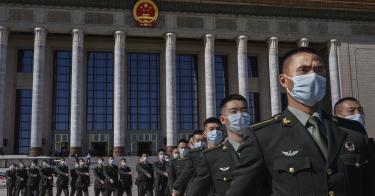China has laid out the broad goals and objectives for its 14th Five Year Plan (FYP), which will extend from 2021 to 2025, and one of the priorities is “elevating the level of national security.”
While Americans may be inclined to dismiss any budget plan more than a year out, five year plans are an important part of the planning process for the People’s Republic of China (PRC). When something is incorporated into the FYP this merits a LOT of attention because it reflects broad bureaucratic consensus. No ministry or bureaucracy will submit something for inclusion in the FYP unless it has reached internal agreement. Similarly, they will fight to ensure their goals and objectives are fully funded if challenged.
Economic, technological, and supply chain security clearly will be priorities. There is concern about preserving societal stability, a key goal of a state that has been beset by persistent and widespread civil disturbances over the last decade.
For example, there is continued emphasis on urbanization, while reducing the divide between urban and rural development. This suggests the Chinese leadership sees the growing disparities between the countryside and the cities as a major source of concern. Since these gaps also emphasize the gap between coastal provinces (which have generally benefited from the policies of “Reform and Opening” pursued since the days of Deng Xiaoping) and inland ones, any effort to improve rural populations will also likely see benefits accrue to inland provinces.
At the same time, however, it may suggest there are growing internal security issues attending this growing inequality. Bo Xilai, the fallen party chief of Chongqing (a provincial level city that is deep inland), had clearly sought to exploit these gaps in his efforts in 2012 to rise to the CCP Politburo, the core power group in China. Both Bo and his successor Sun Zhengcai were toppled after reportedly plotting to use their position to challenge Xi Jinping and the CCP leadership.
Improving external security is also clearly a priority for the CCP in the coming FYP. The Chinese have been modernizing the People’s Liberation Army (PLA) for more than two decades. For a long time, the PLA has been described as “half-mechanized, half-informationized.” While some units of the PLA employ data links, network-centric sensor-to-shooter system-of-systems, and field a variety of UAVs, electronic warfare platforms, and advanced combat capabilities, other units are still in the midst of simply shifting from towed artillery to self-propelled guns, improving their main battle tanks and becoming fully motorized.
For the next FYP, the goal is to accelerate military modernization, so the PLA will be fully mechanized and informationized by 2027. The PLA was founded in 1927, so the 2027 target date is in part an effort to capitalize on the centennial of its founding. Nonetheless, to accelerate informationization will require either a major reduction in forces, a major budget increase or a shift in the standard of what constitutes “informationized” units.
At the same time, this additional effort will simply be continuing a process underway since the Twelfth (2011-2015) and current Thirteenth (2016-2020) FYPs. During the past decade, the PLA modernized much of its equipment; today, it has the world’s largest navy and air force. Crucially, it has significantly evolved its doctrine, adopting concepts such as “integrated [or unified] joint operations (yitihua lianhe zuozhan; 一体化联合作战)” and “civil-military fusion (junmin ronghe; 军民融合).” It has also undergone a radical reorganization (announced on December 31, 2015), with new services such as the PLA Strategic Support Force and the establishment of new “war zones” or “theater commands” to replace the old military regions.
All of these steps marked the initial phase of PLA modernization. The next seven years will likely see adjustments as the PLA assesses the success of these modernization efforts, undertakes course corrections, and otherwise prepares the PLA to enter its next century of development.
For the United States, the implications are significant. China’s efforts at improving its own security are neither simply military, nor occurring at a breakneck pace as new requirements outstrip resources. As Beijing has demonstrated over the past decade, it is undertaking modernization at a measured pace, securing resources (through programs such as the Belt and Road Initiative) while not antagonizing too many other states. Only in the past year-and-a-half, with the advent of “Wolf Warriors,” as well as more peremptorily dealing with partners and aid recipient nations, has China’s reputation lost some of its luster.
Foreign Minister Wang Yi said in June: “We never pick a fight or bully others. But we have principles and guts. We will push back against any deliberate insult, resolutely defend our national honor and dignity, and we will refute all groundless slander with facts.”
In Australia, the Chinese embassy leaked a document on Nov. 18 accusing Australia of a range of activities the PRC doesn’t like, reflecting the increasingly aggressive acts by Chinese diplomats.
This means presumptive President Biden cannot afford to assume that China will implode or otherwise fail as the Soviet Union did.
Instead, the coming decade and beyond will require the United States to work closely with traditional allies in both Asia and Europe since the Chinese challenge will be global. America must work with new partners as well, such as India, the UAE, Saudi Arabia, and various central Asian and African states as China pushes ever harder into these regions with economic and technology-led efforts (such as space and 5G systems).
Managing America’s relationship with a publicly aggressive China will require a far more coordinated effort involving not only traditional military and intelligence efforts (including arms sales), but also financial and economic efforts of our own, to balance Chinese blandishments and subsidized infrastructure development.
This piece originally appeared in Breaking Defense



